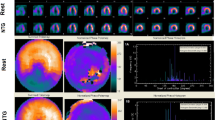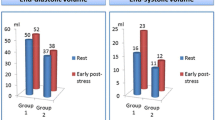Abstract
Purpose
The aim of the study was to evaluate a novel polar map of myocardial viability obtained by gated SPECT imaging to predict functional recovery after revascularization in patients with ischaemic left ventricular (LV) dysfunction.
Methods
The study group comprised 17 patients (15 men, mean age 58 ± 9 years) with ischaemic LV dysfunction (ejection fraction ≤40%) who underwent nitrate-enhanced gated SPECT before and 6 months after coronary revascularization. A parametric image of viable myocardium (VIA) was obtained using a semiautomated method to subtract the point-to-point motion polar map from the perfusion polar map. A parametric image of segments with functional recovery (REC) was obtained by subtracting the baseline motion polar map from the motion polar map after revascularization.
Results
Of the total 340 segments, 248 (73%) were considered viable on the basis of the VIA map. After revascularization, of 248 dysfunctional viable segments 186 (75%) showed an improvement in LV function. An increase in LV ejection fraction (from 30 ± 10% to 42 ± 11%, p < 0.01) and a decrease in end-diastolic volume (from 207 ± 74 ml to 174 ± 74 ml, p < 0.01) were observed after revascularization. Overall concordance between the VIA map and the REC map was 85%, with a k value of 0.63. Sensitivity, specificity, and positive and negative predictive values of the VIA map for predicting functional recovery were 89%, 75%, 91% and 71%, respectively.
Conclusion
The proposed polar map of myocardial viability obtained by gated SPECT imaging accurately predicts functional recovery after coronary revascularization. Thus, a direct quantitative image of viability obtained from perfusion/function matching may be helpful for clinical decision-making in patients with ischaemic LV dysfunction.




Similar content being viewed by others
References
Remme WJ, Swedberg K; Task Force for the Diagnosis and Treatment of Chronic Heart Failure, European Society of Cardiology. Guidelines for the diagnosis and treatment of chronic heart failure. Eur Heart J 2001;22:1527–60.
Cowie MR, Wood DA, Coats AJ, Thompson SG, Poole-Wilson PA, Suresh V, et al. Incidence and aetiology of heart failure: a population-based study. Eur Heart J 1999;20:421–8.
Bax JJ, Poldermans D, Elhendy A, Boersma E, Rahimtoola SH. Sensitivity, specificity and predictive accuracies of various non-invasive techniques for detecting hibernating myocardium. Curr Probl Cardiol 2001;26:147–86.
Underwood SR, Bax JJ, vom Dahl J, Henein MJ, van Rossum AC, Schwarz ER, et al. Imaging techniques for the assessment of myocardial hibernation. Report of a study group of the European Society of Cardiology. Eur Heart J 2004;25:815–36.
Patel RA, Beller GA. Prognostic role of single-photon emission computed tomography (SPECT) imaging in myocardial viability. Curr Opin Cardiol 2006;21:457–63.
Evangelista L, Acampa W, Petretta M, Ferro A, Ricci F, Luongo L, et al. Incremental prognostic value of cardiac single-photon emission computed tomography after nitrate administration in patients with ischemic left ventricular dysfunction. J Nucl Cardiol 2009;16:38–44.
Hesse B, Tägil K, Cuocolo A, Anagnostopoulos C, Bardiés M, Bax J, et al. EANM/ESC procedural guidelines for myocardial perfusion imaging in nuclear cardiology. Eur J Nucl Med Mol Imaging 2005;32:855–97.
Fleiss JL. Statistical methods for rates and proportions. 2nd ed. New York: Wiley; 1981. p. 217–25.
Bax JJ, Ansalone G, Breithardt OA, Derumeaux G, Leclercq C, Schalij MJ, et al. Echocardiographic evaluation of cardiac resynchronization therapy: ready for routine clinical use? A critical appraisal. J Am Coll Cardiol 2004;44:1–9.
Patterson RE, Pilcher WC. Assessing myocardial viability to help select patients for revascularization to improve left ventricular dysfunction due to coronary artery disease. Semin Thorac Cardiovasc Surg 1995;7:214–26.
Allman KC, Shaw LJ, Hachamovitch R, Udelson JE. Myocardial viability testing and impact of revascularization on prognosis in patients with coronary artery disease and left ventricular dysfunction: A meta-analysis. J Am Coll Cardiol 2002;39:1151–8.
Bax JJ, Van der Wall EE, Haebison M. Radionuclide techniques for the assessment of myocardial viability and hibernation. Heart. 2004;90 (Suppl V):26–33.
Cuocolo A, Pace L, Ricciardelli B, Chiariello M, Trimarco B, Salvatore M. Identification of viable myocardium in patients with coronary artery disease: comparison of thallium-201 scintigraphy with reinjection and technetium-99m methoxyisobutyl isonitrile. J Nucl Med 1992;33:505–11.
He ZX, Darcourt J, Guignier A, Ferrari E, Bussière F, Baudouy M, et al. Nitrates improve detection of ischaemic but viable myocardium by thallium-201 reinjection SPECT. J Nucl Med 1993;34:1472–7.
Bisi G, Sciagrà R, Santoro GM, Rossi V, Fazzini PF. Technetium-99m-sestamibi imaging with nitrate infusion to detect viable hibernating myocardium and predict postrevascularisation recovery. J Nucl Med 1995;36:1994–2000.
Maurea S, Cuocolo A, Soricelli A, Castelli L, Nappi A, Squame F, et al. Enhanced detection of viable myocardium by technetium-99m-MIBI imaging after nitrate administration in chronic coronary artery disease. J Nucl Med 1995;36:1945–52.
Sciagrà R, Bisi G, Santoro GM, Agnolucci M, Zoccarato O, Fazzini PF. Influence of the assessment of defect severity and intravenous nitrate administration during tracer injection on the detection of viable hibernating myocardium with data-based quantitative technetium 99m-labelled sestamibi single photon emission computed tomography. J Nucl Cardiol 1996;3:221–30.
Author information
Authors and Affiliations
Corresponding author
Rights and permissions
About this article
Cite this article
Spadafora, M., Varrella, P., Acampa, W. et al. Direct imaging of viable myocardium by gated SPECT in patients with ischaemic left ventricular dysfunction. Eur J Nucl Med Mol Imaging 37, 1730–1735 (2010). https://doi.org/10.1007/s00259-010-1463-8
Received:
Accepted:
Published:
Issue Date:
DOI: https://doi.org/10.1007/s00259-010-1463-8




